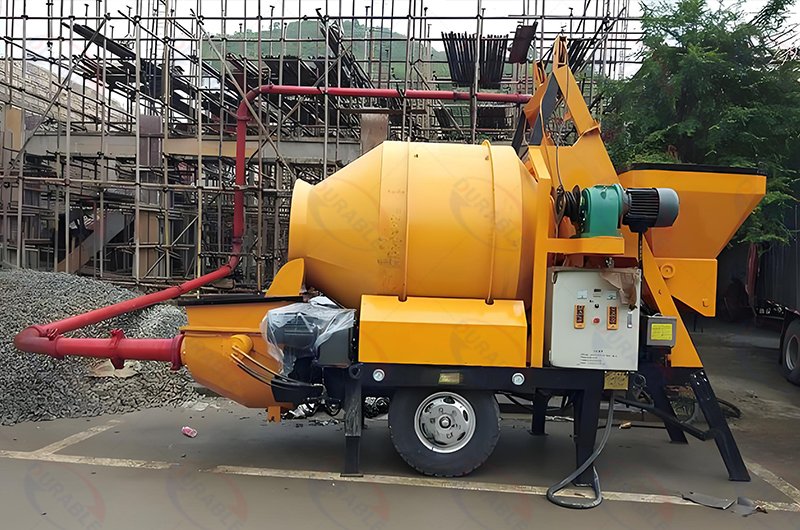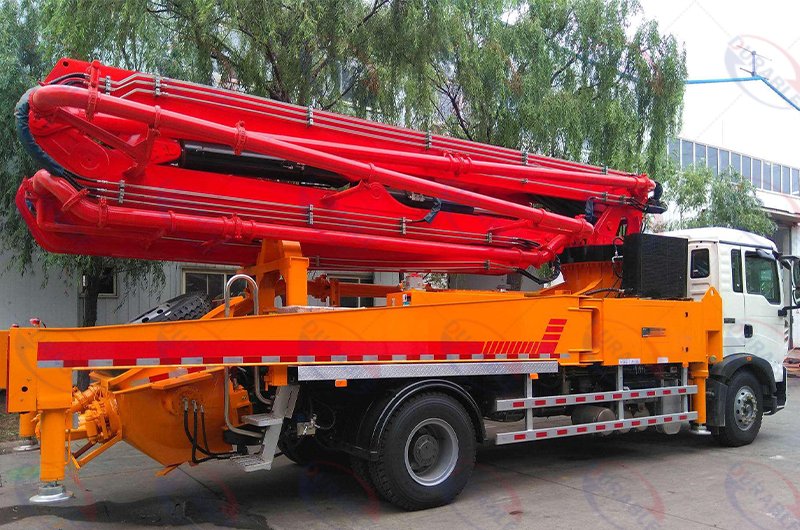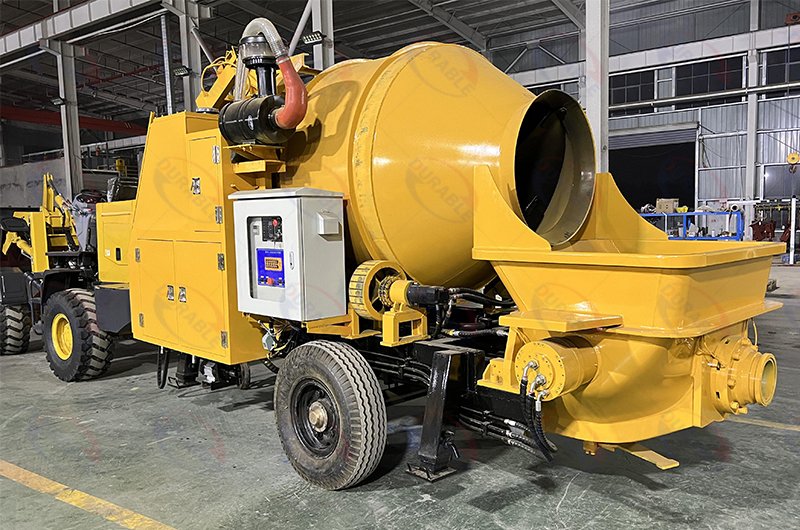Why Use a Concrete Pump Machine for Your Construction Project?
As a long-time engineer at Durable, I’ve seen firsthand how projects get delayed and budgets get broken. One of the biggest bottlenecks is often the simplest task: moving wet concrete from the truck to where it needs to be. For any serious construction project in 2025, using a concrete pump machine is no longer a luxury; it is the core of an efficient, profitable, and safe operation. If you’re wondering how this single piece of equipment can fundamentally change your project’s outcome, this guide will show you how it directly solves your biggest challenges.


Table of Contents
- How can a concrete pump solve project delays and cost overruns?
- How can you pour more concrete with less labor and better safety?
- How do you ensure concrete quality on large, critical pours?
- How does a concrete pump handle difficult sites like high-rises?
- What are the long-term economic benefits beyond the initial cost?
- How do you choose between a boom pump and a trailer pump?
- Frequently Asked Questions
- Conclusion and Next Steps
- About Durable
How can a concrete pump solve project delays and cost overruns?
The biggest enemy on any construction site is wasted time. Relying on traditional methods like a crane with a bucket or an army of workers with wheelbarrows is slow and inefficient. A concrete pump machine solves this by delivering a massive, continuous flow of concrete exactly where you need it. A standard truck-mounted boom pump can place anywhere from 30 to over 150 cubic meters of concrete per hour. Think about what that means for your project. A large foundation or a suspended floor slab that would take all day to pour with a crane can now be completed in just a few hours. This is not just a small improvement; it is a complete transformation of your workflow and schedule.
This incredible speed creates a powerful ripple effect across your entire project. When you finish a massive pour before lunchtime, your concrete finishing crew can get to work immediately. Because the pour is continuous, you avoid “cold joints,” creating a single, stronger monolithic structure. Most importantly, you accelerate the entire project timeline. The site is ready for the next phase—plumbers, electricians, and steel erectors—days or even weeks ahead of schedule. In a business where every day has a significant cost attached to it in terms of labor, equipment rental, and overhead, this acceleration translates directly into major cost savings and earlier project completion. The concrete pump is the engine that drives your project forward, faster.
How can you pour more concrete with less labor and better safety?
Labor is one of the highest and most unpredictable costs in construction. A concrete pump directly addresses this by replacing brute force with mechanical efficiency. The old method required a large team of 10-15 workers just to move concrete. You needed people to load wheelbarrows, navigate a crowded and hazardous site, dump the concrete, and return. With a concrete pump, you need a small, skilled team: one certified pump operator and a few workers at the end of the hose to guide the pour and handle vibration. You are essentially replacing the work of a dozen laborers with one highly efficient machine. This immediately and drastically cuts your direct payroll costs for every single pour.
This reduction in manpower has an equally important second benefit: vastly improved site safety. A job site with fewer people moving around is inherently safer. You eliminate the constant traffic of wheelbarrows, which create trip hazards and site congestion. More critically, you remove the danger of heavy crane buckets swinging overhead, one of the most significant risks on any site. The concrete delivery process becomes streamlined and predictable. The ready-mix truck stays in a designated safe area to feed the pump’s hopper, keeping heavy vehicle traffic isolated. This creates a cleaner, more organized, and significantly safer work environment, which not only protects your workers but also helps reduce your liability and potentially lower your insurance premiums.
How do you ensure concrete quality on large, critical pours?
The final strength and durability of your building depend entirely on the quality of the concrete at the moment it is placed. A concrete pump machine is crucial for protecting the integrity of the concrete mix. During transport in a ready-mix truck, the heavier aggregates can start to settle. The auger in the pump’s hopper constantly remixes the concrete just before it enters the line, ensuring it is perfectly blended. As it travels through the pipeline under pressure, the mix is kept in a homogenous state. This prevents segregation—the separation of aggregates, sand, and cement paste—which is a common problem with methods like wheelbarrows, where the mix can slosh around and separate.
This consistency is not just a minor detail; it is essential for structural engineering. A continuous pour from a pump ensures that the concrete placed at the end of a boom is the exact same high-quality mix that left the truck. This results in a stronger, more uniform final structure with fewer voids, honeycombing, or weak spots. When you are pouring critical structural elements like columns, beams, or suspended slabs, this guarantee of quality is non-negotiable. It ensures you meet the architect’s and engineer’s specifications every time, reducing the risk of failed inspections, costly rework, or long-term structural problems. Using a pump is a form of quality assurance for your most important building material.
How does a concrete pump handle difficult sites like high-rises?
Modern architecture often presents difficult logistical challenges. How do you get concrete to the 40th floor of a high-rise, deep into a tunnel, or into a basement in a crowded city center? Concrete pumps are specifically designed to solve these access problems with precision. For vertical challenges, a truck-mounted concrete boom pump uses a long, articulating robotic arm that can reach up, over, and into a building with pinpoint accuracy. This allows you to pour floors dozens of stories high directly from the street level, without needing cranes or complex material hoists. The operator can guide the end of the hose precisely where it needs to go, minimizing spillage and ensuring an even pour.
For horizontal distance or extremely tight spaces, a trailer-mounted line pump is the perfect solution. Flexible or rigid pipes can be run for hundreds of meters across a site, through windows, down shafts, or around obstacles. This makes previously impossible jobs simple. You can pour a foundation in a backyard without a heavy truck ever touching the lawn. You can reline a tunnel or fill foundation piles in a space too small for any other equipment. This versatility means you can take on more complex and profitable jobs, confident that you have a reliable way to deliver high-quality concrete anywhere. For even more integrated solutions, a concrete mixer pump can combine mixing and pumping functions for ultimate on-site flexibility.


What are the long-term economic benefits beyond the initial cost?
A smart business owner looks beyond the initial purchase price and evaluates the total economic impact of a piece of equipment. A concrete pump offers one of the best returns on investment in the construction industry. The long-term savings and revenue opportunities it creates far outweigh its initial cost.
| Benefit Area | How a Concrete Pump Creates Value For You |
|---|---|
| Project Acceleration | Finishing projects weeks or months early reduces your site overhead, frees up capital for the next job, and avoids costly late-completion penalties. |
| Labor Cost Reduction | Drastically lower payroll for each pour. Your skilled workers can be reallocated to other value-adding tasks instead of just moving material. |
| Improved Material Use | The precise placement minimizes spillage and waste of expensive concrete. You only pay for the concrete that goes into the forms. |
| Enhanced Quality & Reputation | Delivering a consistently higher-quality product reduces the risk of expensive warranty repairs and builds a reputation that wins you more contracts. |
| Increased Project Capability | The ability to tackle high-rise, large-scale, and complex-access jobs opens up new, more profitable markets for your company. |
How do you choose between a boom pump and a trailer pump?
Choosing the right type of concrete pump is crucial for maximizing its benefits. While both move concrete through a pipeline, they are designed for different applications.
- Truck-Mounted Boom Pump: This is an all-in-one unit with a large pump mounted on a truck chassis, complete with a self-contained, remote-controlled robotic arm (the boom). It is the best choice for projects requiring high volume and vertical reach, like multi-story buildings, large slabs, and bridges. They offer rapid setup and are ideal for jobs where speed is the top priority.
- Trailer-Mounted Line Pump: This is a more compact, portable pump mounted on a trailer. It does not have its own boom; instead, you connect a series of steel pipes and rubber hoses to route the concrete to the pour location. It is far more versatile for horizontal distance and is perfect for smaller jobs, residential slabs, swimming pools, and sites with tight access where a large boom truck cannot fit.
The decision is a balance between the scale of your typical projects and your budget. For a diverse range of jobs, many contractors find it beneficial to have access to both types of machines.
Frequently Asked Questions
Q1: How far can a concrete pump push concrete?
A: This depends on the pump’s power and the concrete mix design. A large trailer-mounted line pump can push concrete over 1,000 meters horizontally or over 300 meters vertically. A large truck-mounted boom pump typically has a vertical reach of 30 to 70 meters.
Q2: Is a concrete pump expensive to maintain?
A: Like any heavy machinery, it requires regular maintenance. The main wear parts are the pipes, elbows, and pump cylinders, which handle abrasive concrete. However, a proper daily cleaning and a proactive maintenance schedule make the costs manageable and are far less than the cost of project delays from using slower methods.
Q3: What kind of concrete mix is needed for a pump?
A: You need a “pumpable” mix. This means it must have a good balance of sand and aggregate, with enough cement and water to be fluid, but not so much that it segregates. Most ready-mix suppliers are experts at creating mixes specifically designed for pumping.
Conclusion and Next Steps
In modern construction, efficiency is profit. A concrete pump machine is the single most effective tool for boosting that efficiency. It allows you to pour concrete faster, with a smaller crew, to a higher standard of quality, and with greater safety than any other method. It solves the logistical challenges of high-rise and complex sites and provides a clear and rapid return on investment by accelerating your entire project schedule. It is not an expense; it is a strategic investment in your company’s growth and profitability.
About Durable
We are Durable Machine, a leading Chinese manufacturer of construction and mineral processing equipment since 2001. We specialize in providing powerful and reliable B2B solutions to contractors and distributors worldwide. As a factory-direct seller, we offer competitive pricing and customization on a full range of equipment, from concrete pumps and batching plants to crushing and screening lines. Our machinery is trusted by clients in over 120 countries to deliver performance on the world’s toughest job sites.
Ready to boost your project’s efficiency? Contact our engineering team today to discuss your needs and get a customized quote for the right concrete pump solution.
 Durable Machinery
Durable Machinery